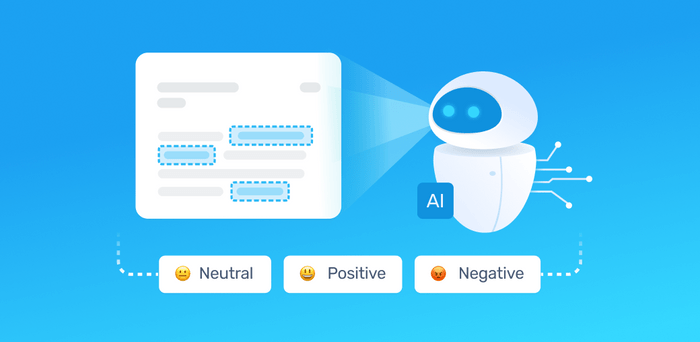
Mastering Deception Defense: AI’s Impact on Fraud Detection in Marketing
August 14, 2023
Beyond Metrics: Transforming Marketing Campaigns with AI-Enhanced Social Media Analytics
August 15, 2023In a world where technology continuously evolves, understanding consumers’ emotions, preferences, and opinions has become a paramount concern for businesses. This understanding offers a competitive edge, allowing companies to tailor their products and services to meet the market’s ever-changing needs. The emergence of artificial intelligence (AI) and machine learning has paved the way for a new era where AI can essentially read minds, enabling businesses to comprehend consumer sentiments. In this blog post, we explore AI-driven sentiment analysis, its multifaceted applications, implications for businesses, challenges, and the exciting path forward.

Unveiling Sentiment Analysis: Decoding the Emotional Web
The Essence of Sentiment Analysis
At its core, sentiment analysis is akin to teaching machines to understand human emotions. It enables them to discern whether a product review is positive, negative, or neutral and interpret the emotions behind social media posts. Sentiment analysis, or opinion mining, involves harnessing advanced algorithms to analyze extensive textual data. By doing so, AI systems can provide insights into public opinions on an unimaginable scale.
From Words to Emotions: How It Works
Sentiment analysis follows a series of steps to decode emotions embedded in textual content. The journey begins with text preprocessing, where AI systems clean and organize the data by removing noise, punctuation, and other extraneous elements. Next comes feature extraction, where the AI identifies crucial attributes such as word frequency, sentiment-related keywords, and contextual cues. Armed with these features, the AI employs sentiment classification algorithms, often grounded in machine learning models, to categorize the text into positive, negative, or neutral sentiments.
The Rise of Emotional AI
While sentiment analysis initially focused on textual data, the evolution of AI has broadened its scope to include emotions conveyed through images, voice tones, and even biometric data. Emotionally intelligent AI can analyze facial expressions in photos, vocal inflections in audio recordings, and physiological signals like heart rate variability to determine emotional states. This expansion has given rise to AI that recognizes sentiments and comprehends them.

AI and Sentiment Analysis: A Perfect Match Made in Tech Heaven
Why AI Is a Game-Changer
The synergy between AI and sentiment analysis is a revolution in the making. AI brings unparalleled scalability and speed to the table. With the capacity to process massive datasets in real time, AI enables sentiment analysis on a global scale. Moreover, AI’s contextual understanding abilities allow it to navigate the intricate nuances that make human language rich and complex.
The Role of Natural Language Processing (NLP)
The robustness of sentiment analysis owes much to Natural Language Processing (NLP). NLP equips AI systems with the capability to understand human language as it is spoken naturally. This encompasses idiomatic expressions, slang, and cultural references that add layers of complexity to communication. By mastering these intricacies, AI-powered sentiment analysis can more accurately capture the true essence of human communication.
The AI Arsenal: Models and Techniques
Sentiment analysis harnesses an array of models and techniques to deliver precise results. Supervised learning involves training AI on labeled datasets, enabling it to learn from examples of positive, negative, and neutral sentiments. In contrast, unsupervised learning takes an exploratory approach, uncovering patterns and clusters in data without preassigned labels. The rise of deep learning, mainly through neural networks, has facilitated the analysis of intricate and layered sentiments, enriching the depth of understanding.

Business Applications of AI-Powered Sentiment Analysis
Customer Insights and Market Research
Understanding customer opinions is a cornerstone of effective business strategies. AI-driven sentiment analysis offers real-time insights by analyzing customer feedback, reviews, and social media conversations. This wealth of information allows businesses to identify trends, preferences, and pain points, providing a solid foundation for refining their offerings.
Brand Reputation Management
In the age of social media, brand reputation can change instantly. AI-powered sentiment analysis is invaluable for monitoring social platforms for brand mentions and associated sentiments. With this real-time tracking, businesses can promptly address negative sentiments and leverage positive ones, ensuring their brand’s image remains positive.
Product Development and Enhancement
The feedback loop between customers and product development is crucial. AI-driven sentiment analysis uncovers specific product features or aspects customers appreciate or dislike. With this knowledge, businesses can iteratively enhance their products, aligning them more closely with customer expectations.
Tailored Marketing Strategies
Generic marketing strategies often need to be more engaging with customers. AI-powered sentiment analysis empowers businesses to create targeted marketing campaigns that resonate with specific customer segments. By comprehending the emotions and sentiments of their target audience, companies can craft messages that resonate, leading to higher engagement and conversion rates.

Challenges and Future Innovations
The Challenge of Contextual Ambiguity
AI-powered sentiment analysis has made remarkable progress but still grapples with contextual ambiguity. Detecting sarcasm, irony, or double meanings remains a challenge. Researchers are actively working on enhancing AI’s contextual understanding to minimize misinterpretations.
Data Privacy and Ethics
As sentiment analysis delves into personal sentiments, concerns about data privacy and ethical considerations emerge. Striking a balance between leveraging data for insights and safeguarding individual privacy is an ongoing challenge that requires careful navigation.
Multilingual and Cultural Nuances
Different languages and cultures express sentiments uniquely. AI systems must adapt to these variations to ensure accurate analysis across diverse demographics. This necessitates ongoing learning and adaptation by AI models.
Emotionally Intelligent AI
The future of sentiment analysis lies in developing emotionally intelligent AI. This means creating AI systems that recognize sentiments and understand the underlying emotions. Researchers are actively exploring ways to imbue AI with emotional comprehension, making it even more proficient at understanding human communication.

Embracing the Sentimental Shift: The Road Ahead for Businesses
Integration and Adoption
The potential benefits of AI-powered sentiment analysis are vast, but effective adoption is critical. Businesses that embrace sentiment analysis as an integral part of their strategy stand to gain a significant competitive edge. Integrating AI into existing processes and decision-making frameworks is essential for success.
Skill Enhancement
AI serves as a tool that enhances human capabilities. Professionals need to upskill themselves to work effectively with AI systems. The synergy of human intuition and AI precision often leads to optimal results, creating a harmonious balance between technology and human expertise.
Ethical AI Implementation
Ethics and data privacy must be at the forefront of AI implementation. Companies must ensure transparent communication about customer data use, maintain data security, and avoid bias in sentiment analysis results. Trust-building measures are critical.
Creative Collaboration
With AI handling the analytical heavy lifting, creative minds have more room to explore innovative strategies, content, and campaigns. AI insights can serve as sparks that ignite creativity and open new avenues for engagement, enabling businesses to differentiate themselves in the market.
FAQs: Demystifying AI-Powered Sentiment Analysis
What Is AI-powered Sentiment Analysis?
AI-powered sentiment analysis uses advanced algorithms and machine learning techniques to discern the emotional tone and opinions expressed in text, audio, or visual content. It enables computers to understand and interpret human emotions and attitudes.
How Accurate Is AI in Interpreting Emotions?
AI’s accuracy in interpreting emotions varies based on factors such as the complexity of the sentiment and the quality of training data. While AI has made significant advancements, there are still instances where nuanced emotions are challenging to capture.
Can Sentiment Analysis Replace Human Intuition?
AI enhances human capabilities but doesn’t replace intuition entirely. Combining AI’s data-driven insights and human understanding produces the best outcomes. Human instinct brings context, empathy, and a deeper understanding.
Is AI-Powered Sentiment Analysis Expensive to Implement?
While there might be initial setup costs for integrating AI systems, the long-term benefits of better decision-making, enhanced customer satisfaction, and improved business strategies often justify the investment.
How Can Small Businesses Leverage AI for Sentiment Analysis?
Several AI platforms offer affordable sentiment analysis tools tailored to the needs of small businesses. These platforms often provide user-friendly interfaces and pre-built models that facilitate easy adoption and implementation.
A Sentimental Revolution in Business
The convergence of AI and sentiment analysis is redefining the landscape of business. By deciphering consumer sentiments, AI empowers companies to make informed decisions, devise personalized strategies, and foster more profound connections with their audience. As AI’s emotional intelligence continues to evolve, the possibilities for understanding and responding to consumer sentiments are boundless. In this thrilling journey toward customer-centric success, businesses must embrace AI’s potential, navigate its intricacies, and innovate with technology.


